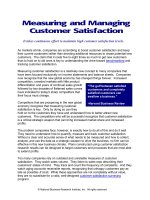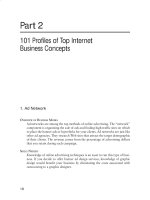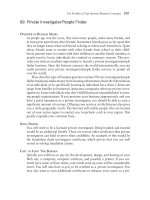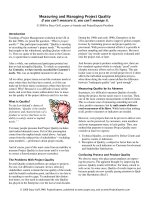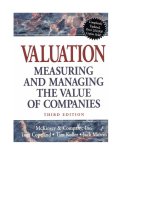Measuring and Managing Project Quality - If you can’t measure it, you can’t manage it pptx
Bạn đang xem bản rút gọn của tài liệu. Xem và tải ngay bản đầy đủ của tài liệu tại đây (337.27 KB, 5 trang )
© 2008 Stacy Goff, PMP, ProjectExperts; published at www.asapm.org, and at www.ProjectExperts.com
Measuring and Managing Project Quality
If you can’t measure it, you can’t manage it.
© 2008 by Stacy Goff, asapm co-founder and ProjectExperts President
Introduction
Teaching a Project Management workshop in the UK in
the late 1980s, we posed the question, “What is project
quality?” One participant responded, “Quality is meeting
or exceeding the customer’s project needs.” We recorded
that insight on the whiteboard, spelling Qualitty with two
t’s. Then we spoke of the need to be close to the Custom-
ers, to spend time to understand their needs, and so on.
After a while, one embarrassed participant pointed out
that we had misspelled Quality. To which we responded,
Au Contraire, we have merely exceeded the Customer’s
needs. This was an insightful moment for all of us.
All too often, project teams exceed the customer needs in
areas where they feel they have control, as if this can
make up for those many occurrences where they have no
control. Why? Because it is so difficult to know all the
needs, and even then, teams seldom know how to meas-
ure the quality of the project delivery until it is too late.
What Is Quality?
To cite Lew Ireland’s choice of
definitions, “Quality is the totality
of features and characteristics of a
product or service that bear on its
ability to satisfy stated or implied
needs.”
i
Yet many people presume that Project Quality includes
(and indeed demands) more. Part of this presumption
comes from the implied needs stated above. And part
comes from the subjectivity of stakeholders’—including
team members’—preferences about project results.
And of course, part of this must come from an inability to
measure Project Quality in clear terms until it is too late
to correct a flawed project process or product.
The Problems With Project Quality
Several Quality-related problems are unique to projects.
For one, it is difficult to measure. In fact, often key
stakeholders cannot evaluate the true quality of the results
until the benefit realization point, and then it is too late to
do anything to resolve gaps. To understand this distinc-
tion better, we first need to understand the role Quality
has played in the Enterprise over the last several decades.
During the 1980s and early 1990s, Enterprises in the
USA and other countries tried to improve global competi-
tiveness by instituting process and project quality im-
provement. With process-oriented efforts it is possible to
perform sampling and other quality measures. But most
projects’ key results cannot be rigorously evaluated until
near the project end, or later.
And because projects produce something new, there are
few standards against which to evaluate “good” results
(despite nouveaux efforts such as Six Sigma). This par-
ticular issue is not just at the overall project level; it often
affects the individual assignment delegation process,
when those doing the work cannot define the difference
between “inadequate quality” and “good enough”.
Measuring Quality by its Absence
In projects, it is difficult to measure Quality of results
during the project, but far easier once it is too late. Then,
one of the most common measurements is Defect Counts.
This is a classic case of measuring something not with
clear, positive measures, but by unit counts of discov-
ered occurrences of its flaws. While better than nothing
at all, positive measures or indicators are needed.
However, even projects that can be proven to deliver zero
defects can be perceived, by customers, team members
and your management team, to lack quality. Thus, any
method that purports to measure Project Quality must
consider at least two aspects:
1. Technical Quality, as measured by Defect Counts and
positive counts or indicators.
2. Perception of Quality, a subjective factor that can be
measured by such indicators as Customer Involvement
and Stakeholder Satisfaction.
Confusing Process and Product Quality
We observe many who place great emphasis on improv-
ing the process. The apparent thought: by improving the
process, Quality results will follow. For many, mixed re-
sults occur. In some cases, Quality of results improve just
because people are now actually paying attention to Qual-
ity (the Hawthorne effect
ii
).
Measuring and Managing Project Quality; Stacy Goff, page 2
© 2008 Stacy Goff, PMP, ProjectExperts; published at www.asapm.org, and at www.ProjectExperts.com
In other cases, Quality is reduced, as the process mentali-
ty extends to blindly documenting everything, even poor
practices, and then consistently following those practices.
This is the school of “if a little documentation is good,
then too much is better.” Thus actions such as ISO 9000,
intended to improve quality, become a consultants’ trea-
sure hunt while continuing to perpetuate bad practices.
Some Project Management Methodologies adopt the
same mentality, as the “Quality process zealots” win out
over the practical application advocates. Today, many
project practitioners shirk project documentation in re-
sponse to the excesses of that approach. Indeed, such
movements as Lean Manufacturing and Agile PM can be
traced in part to those excesses as well.
The Quality Process Zealots
We observed another horrifying movement that emerged
as Enterprises struggled with a Focus on Quality. We had
balanced all the Project Vital Signs for years, following
the efforts of Juran
iii
, Deming
iv
, Guispari
v
and others. But
some newfound Quality Movement advocates disdained
all gurus except their own. For example, we encountered
one Aerospace Enterprise whose quality experts insisted
that you did not understand Quality unless you used only
the Crosby
vi
dogma, processes, terminology, and tools.
While this type of malpractice tends to occur with every
new fad, it was alarming to see it happen to the Quality
Movement, something that had great benefit for those En-
terprises that managed it well.
The Quality Movement Impact
So is the Quality Movement over? Well, yes and no. Yes,
this fad has passed. But some observations: We saw
many Enterprises that “sheep-dipped” their staff in a
week’s worth of training, and then went on to the next
fad. For them, the moment has passed. We have seen oth-
ers who “walked the talk”, and integrated new ways of
focusing on the Customer, measuring satisfaction, and
balancing quantitative and qualitative measures. For these
groups, Quality is part of their culture.
Discerning Scope From Quality
Sometimes it is difficult to discern Project Scope from
Quality. This may rise from the inherent weaknesses of
trying to manage to the obsolete “triple constraint” or
“golden triangle” (Time, Cost and Technical Perfor-
mance). In that approach, Technical Performance is often
assumed to cover Scope, Quality, and everything else one
cannot remember when under pressure.
To illustrate this distinction between Scope and Quality,
in one of our workshops we use a mini-case study of an
all-expense paid three-week trip to an exotic place. When
it comes time to “Crash the Model”, and we ask if anyone
would reduce Scope to two weeks or one week, if that
was one way to still go, the class reaction is, “No way!”
So then we get into a discussion of whether the Quality is
lower, or if it is Scope that is lower, asserting, that if you
can still have a wonderful time, it is just reduced Scope.
The reaction is usually one of, “If I could
have had three weeks, and now I only
get one week, you have not met my
expectations, and Quality is lower”.
Of course, this is one reason why we
use this mini-case
study. When you
are on the project
team, you may
feel you are only
reducing Scope; but when you are the Customer, the
same actions are clearly reducing Quality.
Impact of Quality in Project Results
So here we are, half way through this article, and the im-
patient reader asks, enough already! When will we talk
about Measuring and Managing Project Quality?
Have patience, we are getting close. See if you can hold
on until the end of this page, and here is why: We only
solve symptoms if the symptoms are all we understand.
To solve the real problem, we need to understand the
problem. So far we have merely traced how we have got-
ten to this era, where Quality appears only to be impor-
tant when it is missing. What is the consequence of this
Quality gap for your projects?
The consequence is independent of your projects’ pur-
poses. Some projects establish competitive advantage;
some reduce costs; some meet regulatory requirements.
For all purposes, lack of Quality causes your projects to
fail to meet the business need. A failure. Your failure. If
you cannot deliver the needed Quality, then even if your
project meets time, cost and other easy-to-measure fac-
tors, you managed (or failed to manage) a failed project.
Thus, while we use Benefit Realization as a Primary Suc-
cess Measure, the right Quality for the right Scope is the
greatest contributor to your success, far more important
than other easier-to measure indicators. Which brings us
(finally) to the theme of this article: Measuring and Man-
aging Project Quality.
Measuring and Managing Project Quality; Stacy Goff, page 3
© 2008 Stacy Goff, PMP, ProjectExperts; published at www.asapm.org, and at www.ProjectExperts.com
Can It Be That Difficult To Measure Quality?
Yes it can. That is
why less-competent
Program and Project
Managers focus on
measuring the easy
factors. There exist
several solutions to
this difficulty, includ-
ing using the classic
Input : Process : Out-
put model as the basic building block of quality mea-
surement, the individual project work package or activity
assignment.
• Assure Proper Inputs; selecting appropriate talent for
each assignment, then using effective delegation with
information about how the results will be evaluated.
• Specify Quality Processes, then monitor the results,
and correct the processes that produce defects.
• Review the Outputs or Results, using appropriate re-
view levels and participants. Monitor review outcomes
and correct the inputs and processes, as needed.
The less-competent practitioner whines, “But this will
cost too much, take too long, and still gain us nothing!”
Fine; stick with your incompetent status quo. In fact, if all
you really want to do is save cost and time, don’t even
bother doing the project!
While the above Input : Process : Output model can help
establish a foundation for measuring project Quality, it
still does not actually measure it. Thus we need more, so
we can catch problems earlier. Effective Program and
Project Managers add other measures.
Measure Ease By Nature of Project
The nature of the project affects Quality measurement
difficulty. In “Hard Product” projects, those that produce
tangible, physical products, it is easier to review incre-
mental Quality of the results. You can test a mile of six-
lane freeway, or the foundations of a six-story building.
“Soft Product” projects are those that produce a less-
tangible result. These may range from an Aerospace Re-
search and Development project to a Pharma program to
develop a new cancer cure, to an Information Technology
project to support a new web-based collaborative solu-
tion. For these project types, it is more difficult to meas-
ure the quality of the result by reviewing the incremental
assignment results—although for this type of project that
is an even more important factor.
For both these project types, we use Measures, where
available, and Indicators, where measures are not avail-
able. A key measure is Defect Count, or more appro-
priately, Planned versus Actual Defect Count (we also
count as a Defect any earlier review that should have
caught a defect).
Indicators of Quality
We also use Indicators of Quality. These are very useful,
especially very early in projects, when Defect Counts
may not be available. What are Quality Indicators? These
are evidence that certain aspects of Project Quality are in
place. These can be global, across the project, or incre-
mental, for individual assignments. And, a Project Man-
ager can monitor the Indicators for improvement when
responsibility, process or talent adjustments are made.
Here are several Indicators we’ve used in a range of
project sizes, from very small to multi-billion dollar ones.
Note that many of them relate to the subjective side of
Project Quality, or the Perception of Quality.
• Engagement Measures: Internal Customer involvement
in key project activities; expected vs. actual.
• Planned vs. Actual Cumulative Review Count.
• Assessment Measures: Customer satisfaction surveys;
stakeholder expectations evaluation.
Engagement Measures are early indicators of the level of
Customer acceptance and probable benefits realization.
Appropriate Customer engagement in activities such as
Requirements Definition, Design decisions, and the clas-
sic Customer-satisfaction determinants of Testing, Do-
cumentation and Training have huge impact on project
success. An effective Project Manager (with the support
of her Sponsors) can improve Perception of Quality by
assuring proper Customer involvement in these activities.
Our favorite Indicator is the Planned versus Actual Cu-
mulative Review Count. Of course, to use this Indicator,
you must plan incremental reviews of results, not just
“big bang” end-of-phase reviews of everything delivered.
New for many, here is how it works. Consider the table
below, showing planned vs. actual cumulative reviews.
Week PlannedReviews ActualReviews Q‐Status
2 1 1 100%
4 3 2 67%
6 4 2 50%
8 6 3 50%
10 7 3 43%
12 9 4 44%
Measuring and Managing Project Quality; Stacy Goff, page 4
© 2008 Stacy Goff, PMP, ProjectExperts; published at www.asapm.org, and at www.ProjectExperts.com
In the above example, the Time and Cost data, as re-
ported on timesheets and Status Reports show “On Tar-
get”; but what is the truth?
Managing Quality: Effective Reviews
Do Reviews or Inspections of in-process results improve
Quality? No, Reviews or Inspections merely detect it, or
its absence in a component of the result. Ideally, this de-
tection occurs early enough after defect creation to avoid
contaminating downstream results. As has been illu-
strated multiple times, correcting sooner costs less.
Effective Reviews have the right participants, with the
right preparation, and apply the right process, with exter-
nal facilitation if needed. And, as mentioned earlier, Re-
views are best-done at the completion of key project re-
sults, not in one massive review at the end of a phase. Ef-
fective Reviews should also follow these guidelines:
• Assure proper preparation: if the Review participants
have not studied the materials to be reviewed before the
session, their evaluation is suspect.
• Review the results, not the performer. We’ve seen too
many Reviews that failed to follow this practice, to the
extent that the Review feels more like an inquisition.
• Find the problems, not the solutions to them.
• Assure follow-up on open items. We’ve audited
projects that still had review open items at the end.
The Role of Quality Assurance
Project Quality involves much more than Reviews. To
many people (especially in some disciplines), Quality As-
surance is something you do just before you throw the re-
sults over the fence to a project victim. But assurance of
quality starts with effectively delegating and managing
individual work package or activity assignments. The di-
agram below shows increasingly-effective levels of Qual-
ity Assurance, based on Deming’s 1 : 10 : 100 rule.
Work Effort
Preview
Review
R
e
w
o
r
k
View
Level3Level2Level1Level0
Level 0 is the cheapest way to assure Quality of results:
Let your Customer find the defects. Of course, while effi-
cient, it is totally ineffective. Level 1 applies Reviews to
detect and correct incremental defects in work products.
Level 2 catches the defects in their commission, and not
only corrects them, but corrects the process, skill gaps, or
misdirection, the three biggest defect sources.
Level 3 plans for higher quality from the start, assuring
the right skills for the job, effective delegation, and a
sense of ownership in the estimates for the assignment.
Why is it a 1 : 10 : 100 rule? Because what costs you $1
to manage at Level 3 costs you $10 if you wait for Level
2, and $100 if you wait until Level 1. Of course, the cost
of a dissatisfied Customer is impossible to measure.
Prerequisites of Quality
Given attention to effective Reviews, there is more to
managing Quality; especially when you recognize that
Reviews merely detect the presence or absence of Quality
in the results. A list of the prerequisites of Quality from
our PM workshops shows the factors that must be in
place to even have a hope of producing Quality results.
• Produce Realistic Plans.
• Involve Customers and Clearly Understand Needs.
• Use Repeatable and Repeated Processes.
• Engage Competent Team Members.
• Assure Team Member Ownership.
• Demonstrate Effective, Informative Delegation.
• Plan and Staff Appropriate Reviews.
• Assure Proper Testing, Documentation, And Training.
Clearly (or perhaps not so clearly to some), this rank-
ordered list provides the foundation for Quality Manage-
ment. Of course, it requires Quality Management to
achieve this scenario. For example, the team that builds
the project schedule by working backwards from an im-
possible deadline has no hope for project Quality.
Here Comes the Judge
Your Sponsors and Cus-
tomers, whether internal or
external, are ultimately the
Judges and the Jury of
the Quality of your results.
These are the stakeholders
who must “buy in” to the
project results early and
often if they are to achieve
the intended project bene-
fits.
Customer engagement in the key project activities men-
tioned above provides one way to assure this incremental
ownership; involvement in appropriate reviews is anoth-
er. And, maintaining communication to improve the per-
ception of responsiveness throughout the project is the
third leg of a Quality focus that gets project results.
Measuring and Managing Project Quality; Stacy Goff, page 5
© 2008 Stacy Goff, PMP, ProjectExperts; published at www.asapm.org, and at www.ProjectExperts.com
Quality and Enterprise Change Management
The indicators and measures we have discussed are also
essential for success in Enterprise Change Management.
Here terminology problems exist because different
groups use this phrase to mean different things. Some
think Change Management is for changes in Scope or
other Vital Signs during the project. Coders think it
means keeping track of the software they are writing. The
way we use it relates to the success of the Enterprise in
preparing for and embracing the changes resulting from a
project and thus realizing the promised project benefits.
We use the key Customer involvement activities men-
tioned above as predictors of successful Enterprise
Change Management These indicators are also measura-
ble early enough to redirect a project that is going astray.
Quality and the Team’s Perception
Stakeholders beyond the Customer are also judges of
Project Quality. The Core Team, those persons who are
performing the work of the project, must also feel a sense
of pride, ownership and accomplishment for their efforts.
This affects the Perception of Quality measures, which,
we remind you, are just as important as defect measures
in the results. Similarly, the extended management team
must perceive the Quality of the process and of the re-
sults, which accentuates the importance of Communica-
tion Competence in your project efforts.
In Conclusion
Effective teams have just as much difficulty measuring
and managing project Quality as do ineffective ones.
However, effective teams identify the factors they can in-
fluence that affect both the defect rate in results, and the
perception of Quality. Ineffective teams trade-off Quality
for the easier-to-measure project success factors. Effec-
tive Program and Project Managers establish the prere-
quisites of Quality, and monitor their success in maintain-
ing those prerequisites from individual assignments to
overall project results.
About the Author
STACY A. GOFF is president of Pro-
jectExperts
®, a Project Management
consulting, methods, tools and training
company. A co-founder and current
Secretary-Treasurer of asapm, Stacy is
the USA representative to IPMA, the
International Project Management As-
sociation. He has also contributed to
the success of Project Management Institute since 1983.
A Project Management practitioner since 1970 and con-
sultant since 1982, his focus is to improve Enterprise or
workgroup project management competence, productivi-
ty, and effectiveness. Mr. Goff provides project consult-
ing services and presents workshops of great interest to
Executives, managers, project managers and leaders,
technical staff, and individual contributors.
His Project Management tools and methods are used by
enterprises and consultancies on five continents. His
workshops have helped over 45,000 people improve their
project success. He combines his PM Process insights
with sensitivity for the human aspects of projects.
The result: Measurably increased project performance.
References
i
Ireland, Lewis R. Quality Management For Projects and Pro-
grams, Project Management Institute, 1991.
ii
In Western Electric’s Hawthorne factory outside Chicago, a
research study that originally focused on the impacts of light-
ing was later re-interpreted to find that paying attention to
process had significant short-term impact on performance.
iii
Juran, J.M. Juran’s Quality Control Handbook, 4th Edition,
McGraw-Hill, 1988. Juran made great contributions to the
understanding of Quality measurement, most of which are
relevant to today’s Projects.
iv
Walton, Mary. The Deming Management Method. Peregree
Books, 1986. After the 2
nd
World War, Deming helped Japan
rebuild, and laid the foundation for the 1980’s Quality
Movement back in the USA, when we suddenly realized we
could not compete without improving Quality.
v
Guaspari, John. I Know It When I See It. A Modern Fable
About Quality; AMACOM, 1985. Theory Why, AMACOM,
1986. Excellent, approachable insights about Quality.
vi
Crosby, Philip B. Quality Is Free, McGraw-Hill, 1979; Let’s
Talk Quality, Penguin Books, 1990.
